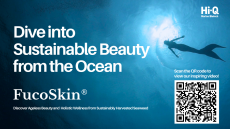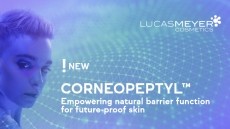Blue biotech in beauty: ‘We have a big task in terms of storytelling’
![There are plenty of stories the beauty industry can tell to help consumers better understand blue biotechnologies and ingredients developed in this way [Getty Images]](/var/wrbm_gb_food_pharma/storage/images/_aliases/wrbm_large/publications/cosmetics/cosmeticsdesign-europe.com/article/2023/03/21/blue-biotech-in-beauty-needs-better-storytelling-and-consumer-engagement-say-experts/16270672-1-eng-GB/Blue-biotech-in-beauty-needs-better-storytelling-and-consumer-engagement-say-experts.jpg)
At this year’s Cosmoprof Worldwide Bologna held in Italy last week, Melissa Hago, VP of beauty at trend forecasting and consumer insights firm Fashion Snoops, hosted an expert panel discussion on the future of blue biotechnology – the application of science and technology to living aquatic organisms for the production of knowledge, goods and services.
So, as the world navigated its way through the United Nations’ decade of ocean science for sustainable development (2021-2030), just how much promise did blue biotech hold for beauty?
‘Life started in the ocean’
Professor Giovanni Scapagnini, a specialised researcher in biochemistry and molecular biology at Italy’s University of Molise, said there was a phenomenal amount to discover still in today’s oceans.
“On this planet, life started in the ocean,” Scapagnini told attendees at the Cosmotalks panel session. “And from an evolutionary point of view, when the organisms moved from water to mainland, they brought with them half of the secrets. You know what is the most closely linked substance to the mineral concentration of water? Human blood. The ocean is still lending a lot of secrets that will, in terms of perspective, really change the story of sustainability on this planet,” he said.
The world tended to look at the ocean as a “victim of pollution”, he said, but the reality was that the ocean offered “part of the puzzle” to solve today’s planetary problems – across many industries, including nutrition and cosmetics.
Blue biotech in beauty today
Many beauty brands were already using blue biotechnologies to develop innovative formulations and ingredients, including L’Oréal’s luxury skin care brand Biotherm.
Dania Blin, sustainability director at Biotherm, said the main ingredient used in the brand’s skin care range was plankton, developed using a biofermentation method that ensured stability and efficacy via a “fully-renewable and sustainable process”.
Similarly, Swedish organic cosmetics startup L:a Bruket was using purely lab-grown microalgae based ingredients in its range of skin and hair care formulas – a project it had worked on alongside a government university on.
Mats Johansson, co-founder of L:a Bruket, said the company had explored “different kinds of versions of algae” and was growing microalgae at its factory to keep the cell shells to make into a powder and integrate into formulas.
“This shell is as amazing as any seaweed algae-based ingredient because they’re all multipurpose; they need to capture sunlight and preserve themselves from the environment around them and they need to make sure they can extract nourishment. All these properties remain in the shell,” Johansson said.
Fellow Swedish skin care and supplements startup Tiny Associates was also using biotechnology ingredients across its range, running a ‘post-natural’ campaign to push the sustainability story behind the science.
“We didn’t intentionally go after blue biotech,” said David Koo Hjalmarsson, CEO and founder of Tiny Associates. “First, it was all about biotechnology in general. And the humble mission we are on at Tiny Associates is trying to become the proof of concept with consumers that biotech is really exciting stuff and it’s a tool that can not only be applied for cosmetics but also for fashion, food (…) It’s really much larger than the cosmetics industry.”
Consumer engagement, however, was vital no matter what the category, he said.
‘How can we frame the story of biotechnology?’
“There is a lot of research showing that the adoption of disruptive innovation related to sustainability is not just rational, it’s emotional,” Hjalmarsson said.
“I really think that we all have a big task in terms of storytelling: how can we frame the story of biotechnology, so it really makes sense and is meaningful to [consumers]?”
One way forward could be reframing it and talking about processes like fermentation or other extraction techniques, he said, to simplify the concept of blue biotechnology for consumers, because as it stood it remained “very, very complicated” for most.
“We really need to find a smart way to demystify biotech; take away a bit of the science to explain what it is, the benefits of it and try and find nice slogans,” he said.
Wine, beer and real-world issues
Scapagnini suggested that using the wine industry as a reference could be one smart way of simplifying it for consumers. “From a nutritional point of view, the first biotech product of humanity has been wine, and it’s something people understand. Wineries are small biotech companies because they work mostly with fermentation,” he said.
But no matter what the strategy, the researcher said communication around biotech would require smart marketing efforts – “it’s a story to tell”.
Robert Evans, co-founder of US microalgae supplier Purissima, specialised in a patented fermentation platform to develop ingredients, agreed that drawing analogies to alcohol fermentation, be that wine or beer, could be one strategy as most consumers could relate to these products and processes.
Industry could then connect the concept of blue biotech to “real-world issues” around sustainability, offering a very clear way for consumers to “consume responsibly and in a way that doesn’t accelerate the deterioration of the planet”, Evans said.
Johansson agreed: “It’s important to explain [biotech] and de-dramatize the word and make it more accessible and relevant on a daily basis to create the trust, both from a product efficiency point of view but also from a sustainability point of view. We have a job to do to make it accessible for everyone.”
‘Innovation coming from the sea’
Scapagnini said accessibility and understanding of biotech would be key if industries were to truly utilise the potential offered by the ocean.
“As a researcher, I am always amazed, every day, about the innovation coming from the sea,” he said. “And every time I start to work with something I think is interesting for one reason, the day after, I discover more and more and more and more. Really, it’s a no-limit highway for me and my brain, and it’s amazing.”
![Whilst algae remains the most widely used in beauty and personal care, there remain a vast array of other marine ingredient resources largely untapped [Getty Images]](/var/wrbm_gb_food_pharma/storage/images/_aliases/wrbm_medium/publications/cosmetics/cosmeticsdesign-europe.com/headlines/formulation-science/marine-ingredients-for-beauty-still-underexploited-though-algae-most-widely-used-finds-review/16285450-1-eng-GB/Marine-ingredients-for-beauty-still-underexploited-though-algae-most-widely-used-finds-review.jpg)

![As the sustainable beauty space booms, building and maintaining trust with consumers will be key for brands [Getty Images]](/var/wrbm_gb_food_pharma/storage/images/_aliases/wrbm_medium/publications/cosmetics/cosmeticsdesign.com/headlines/business-financial/sustainable-beauty-executives-say-brands-must-rethink-marketing-to-include-certification-value-for-money-and-education-efforts/16053911-1-eng-GB/Sustainable-beauty-executives-say-brands-must-rethink-marketing-to-include-certification-value-for-money-and-education-efforts.jpg)
![The adoption of the Kunming-Montreal Global Biodiversity Framework (GBF) at last month's COP15 should provide a stronger means for implementation of finance and strategies to protect biodiversity [Getty Images]](/var/wrbm_gb_food_pharma/storage/images/_aliases/wrbm_medium/publications/cosmetics/cosmeticsdesign.com/article/2023/01/03/un-biodiversity-conference-cop15-in-montreal-results-in-historic-deal-to-protect-people-and-planet/16052336-1-eng-GB/UN-Biodiversity-Conference-COP15-in-Montreal-results-in-historic-deal-to-protect-people-and-planet.jpg)






















